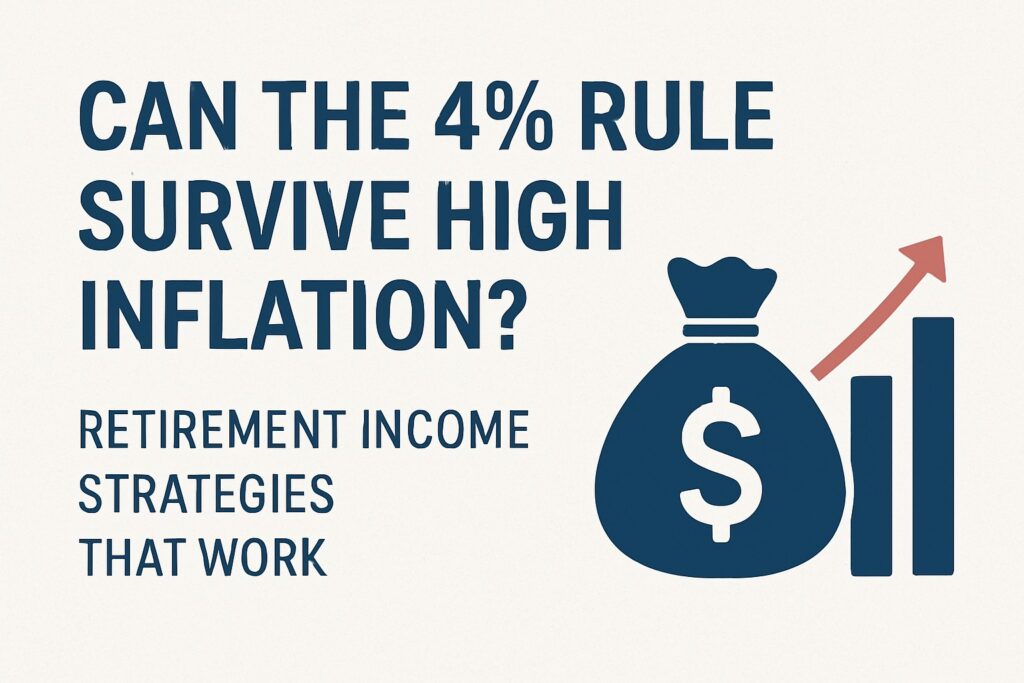
Introduction: A Classic Rule Meets a New Economic Reality
For decades, the 4% Rule has been a cornerstone of retirement planning. The idea is simple: withdraw 4% of your portfolio in the first year of retirement, then increase that amount annually for inflation. Historically, this strategy allowed retirees to maintain income for 30 years or more.
But today’s economic environment looks very different. With inflation still elevated, interest rates shifting, and market volatility testing even the most diversified portfolios, retirees are asking an important question:
Can the 4% Rule survive high inflation?
As a fiduciary financial advisor, the answer is clear:
It can… but only with careful adjustments and updated strategies.
Let’s break down what retirees need to know.
Why High Inflation Challenges the 4% Rule
- Inflation Erodes Purchasing Power Faster
Inflation increases the amount you must withdraw each year.
For example:
- If inflation is 2%, a $40,000 withdrawal becomes $40,800 in year two.
- If inflation is 7%, that jumps to $42,800—a much bigger strain on your portfolio.
When withdrawals rise faster than investment returns, the portfolio may deplete too quickly.
- Sequence-of-Returns Risk Becomes More Dangerous
If markets drop early in retirement while withdrawals increase due to inflation, the long-term damage can be permanent.
High inflation often correlates with market volatility—making this risk even greater.
- Bond Yields Don’t Always Protect You
Traditionally, bonds helped offset inflation’s impact. But today:
- Bond yields may lag inflation
- Rising rates hurt existing bond values
- Retirees relying heavily on fixed income may fall behind
This mismatch makes the classic 60/40 strategy less reliable during inflationary periods.
Does the 4% Rule Still Work?
In today’s environment, the original 4% rule is often too rigid to rely on.
However—the concept still works when modernized and supported by dynamic planning.
A 2023 study shows that sustainable withdrawal rates vary between 3.3% and 4.5%, depending on market conditions, inflation, and the retiree’s allocation.
For many retirees, a fixed 4% withdrawal can work—but it must be paired with flexibility and ongoing adjustments.
Fiduciary-Recommended Alternatives to the Traditional 4% Rule
To help retirees better withstand inflation, fiduciaries are shifting toward more adaptive, research-backed strategies:
- The Dynamic Withdrawal Strategy
Instead of withdrawing a fixed percentage each year, retirees adjust withdrawals based on:
- Portfolio performance
- Inflation rates
- Spending needs
This approach reduces income slightly during down markets—protecting long-term sustainability.
Pros: More inflation-resilient
Cons: Income varies year-to-year
- The Guardrails (Guyton-Klinger) Method
This strategy sets “guardrails” around spending.
Withdrawals increase when markets rise—and decrease modestly when markets fall.
This method has been shown to increase withdrawal success rates during inflationary periods without drastically reducing lifestyle.
- Bucket Strategy (Short-Term, Mid-Term, Long-Term)
Retirees segment their money into “time buckets”:
- Bucket 1: Cash for 1–3 years
- Bucket 2: Bonds for 3–10 years
- Bucket 3: Stocks and growth assets for 10+ years
This approach protects short-term withdrawals from inflation shocks and market downturns.
- Income-Laddering With Bonds or Annuities
Treasury ladders, TIPS ladders, and inflation-adjusted annuities can create predictable income streams.
These solutions help ensure that core retirement expenses rise with inflation.
- Hybrid Withdrawal Models
Some retirees combine:
- Fixed income for essential expenses
- Market-based withdrawals for discretionary spending
This allows lifestyle flexibility while protecting financial security.
How Retirees Can Inflation-Proof Their Withdrawal Strategy
✔ Review your withdrawal plan annually
✔ Maintain a diversified, inflation-sensitive portfolio
✔ Consider adding assets like TIPS, dividend stocks, and real assets
✔ Keep at least 1–3 years of cash reserves
✔ Reduce taxes through strategic withdrawal planning (Roth conversions, RMD timing, etc.)
✔ Work with a fiduciary to run inflation stress tests
Retirees who treat withdrawal rates as flexible—not fixed—are far more likely to maintain financial stability throughout retirement.
Final Thoughts: With the Right Strategy, Your Retirement Income Can Survive Inflation
High inflation has challenged traditional retirement rules—but it hasn’t made them obsolete. The 4% Rule can still work, but only if adapted for today’s economic environment.
Retirees should take a dynamic approach, stress-test their plan, and ensure their strategies evolve with changing conditions.
As fiduciary advisors, our priority is helping you build a retirement income plan that withstands inflation, market volatility, and longevity risk.
If you want help evaluating your withdrawal strategy—or updating it for higher inflation—this is the perfect time to review your plan with a trusted fiduciary.
Global View Capital Management (GVCM) is an affiliate of Global View Capital Advisors (GVCA). GVCM is a SEC Registered Investment Advisory firm headquartered at N14W23833 Stone Ridge Drive, Suite 350, Waukesha, WI 53188-1126. 262.650.1030. Registration as an Investment Advisor does not imply a certain level of skill or training. Ryan Peca is an Investment Adviser Representative (“Adviser”) with GVCM. Additional information can be found at www.adviserinfo.sec.gov Global View Capital Insurance Services (GVCI) is an affiliate of Global View Capital Advisors (GVCA). GVCI services offered through Experior Financial Group, ASH Brokerage, and/or PKS Financial. GVCI is headquartered at N14W23833 Stone Ridge Drive, Suite 350, Waukesha, WI 53188-1126. 262-650-1030. Ryan Peca is an Insurance Agent of GVCI.
These views do not necessarily represent the views of GVCM or any of its affiliates. Investment involves risk. The company profile is for informational purposes only and its contents should not be construed as a recommendation. The information on this social media site alone cannot and should not be used in making investment decisions. Investors should carefully consider the investment objectives, risks, charges and expenses associated with any investment.